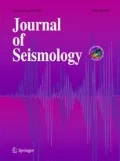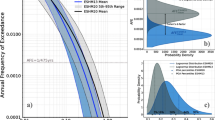Abstract
An assessment of seismic hazard based on the probabilistic approach was undertaken for a low seismic island region, Sri Lanka. Potential source zones in both local and regional contexts were identified in a comprehensive manner based on active tectonic structures and past evidence of seismic activities in the region. This source zonation, because of “dormant to mild seismic nature” of the region, led to characterize most of the regionally dominant seismic sources simply into large area zones. Recurrence rates of seismicity in each of the identified source zones were obtained for pre-estimated periods of completeness, unless otherwise data of a source zone were clearly incomplete due to lack of earthquake records, in which case recurrence parameters were found based on a subjective evaluation concerning the need of conservative recurrence rates for the area. Computed hazard values in terms of expected ground motions (peak ground acceleration (PGA) and spectral accelerations (SAs) at 0.1, 0.5, and 1.0 s natural periods) at rock sites in Sri Lanka for 10% (475-year return period), 5% (975-year return period), 2% (2475-year return period), and 0.5% (9975-year return period) probabilities of exceedance in 50 years’ time were depicted in separate raster maps. Hazard values showed that the area around the capital Colombo possesses maximum expected PGA (in rock sites) which is about 0.11g for a 475-year return period. Most of the other areas indicated relatively low values.

















Similar content being viewed by others
References
Abayakoon SBS (1996) Seismic risk analysis of Sri Lanka. Journal of the Geological Society of Sri Lanka (JGSSL) 6:65–72
Abrahamson NA, Silva WJ (1997) Empirical response spectral attenuation relations for shallow crustal earthquakes. Seismol Res Lett 68(1):94–127
Ammon CJ, Ji C, Thio H-K, Robinson D, Ni S, Hjorleifsdottir V, Kanamori H, Lay T, Das S, Helmberger D, Ichinose G, Polet J, Wald D (2005) Rupture process of the 2004 Sumatra-Andaman earthquake. SCIENCE 308(5725):1133–1139
AS 1170.4 (2007) Structural design actions part 4: earthquake actions in Australia. Standards Australia, Sydney, Australia
Atkinson GM (2004) An overview of developments in seismic hazard analysis. 13th World Conference on Earthquake Engineering, Vancouver, B.C., Canada
Bender B (1983) Maximum likelihood estimation of b values for magnitude grouped data. Bull Seismol Soc Am 73(3):831–851
Bergman EA, Solomon SC (1985) Earthquake source mechanisms from body-waveform inversion and intraplate tectonics in the northern Indian Ocean. Phys Earth Planet Inter 40(1):1–23
Bhatia SC, Kumar MR, Gupta HK (1999) A probabilistic seismic hazard map of India and adjoining regions. Ann Geophys 42(N6):1153–1164
Boore DM (1983) Stochastic simulation of high-frequency ground motions based on seismological models of the radiated spectra. Bull Seismol Soc Am 73(6A):1865–1894
Boore DM, Atkinson GM (2008) Ground-motion prediction equations for the average horizontal component of PGA, PGV, and 5%-damped PSA at spectral periods between 0.01 s and 10.0 s. Earthquake Spectra 24(1):99–138
Chandra U (1977) Earthquakes of Peninsular India—a seismotectonic study. Bull Seismol Soc Am 67(5):1387–1413
Cornell CA (1968) Engineering seismic risk analysis. Bull Seismol Soc Am 58(5):1583–1606
Cornell CA, Winterstein SR (1986) Applicability of the Poisson earthquake-occurrence model. CYGNA Corporation, Seismicity Owners Group, Electric Power Research Institute, California
DeMets C, Gordon RG, Royer J-Y (2005) Motion between the Indian, Capricorn and Somalian plates since 20 Ma: implications for the timing and magnitude of distributed lithospheric deformation in the equatorial Indian ocean. Geophys J Int 161(2):445–468
Esteva L (1970) Seismic risk and seismic design. In: Hansen RJ (ed) Seismic design for nuclear power plants. The M.I.T. Press, Cambridge
Fernando MJ, Kulasinghe ANS (1986) Seismicity of Sri Lanka. Phys Earth Planet Inter 44(2):99–106
Gamage P (2015) Earthquake ground motion models for Sri Lanka. PhD thesis, College of Engineering and Science, Victoria University, Melbourne. http://vuir.vu.edu.au/29730/. Accessed Feb 2018
Gamage P, Venkatesan S (2012) Seismic risk analysis based on historical events reported in Sri Lanka. In 22nd Australasian Conference on the Mechanics of Structures and Materials, ACMSM22, Sydney, Australia, 437–442
Gamage P, Venkatesan S (2013) Coda Q for the Sri Lankan Precambrian crust. Australian Earthquake Engineering Society Conference. City: Hobart, Tasmania
Gamage P, Venkatesan S (2014) Attenuation models for expected ground motions in Sri Lanka. In 23rd Australasian Conference on the Mechanics of Structures and Materials ACMSM23, Byron Bay, Australia, 973–978
Gamage P, Venkatesan S (2015) Attenuation and apparent source characteristics in the northern Indian oceanic crust surrounding Sri Lanka. Bull Seismol Soc Am 106:2041–2057
Gamage P, Venkatesan S (2017) Seismological parameters derived from local earthquakes reported in Sri Lanka. Soil Dyn Earthq Eng 94:158–178
Gamage P, Venkatesan S, Dissanayake R (2011) Seismic drift demand on multi-storey buildings in Sri Lanka due to long-distant earthquakes. In International Conference on Structural Engineering, Construction and Management, ICSECM 2011, Kandy, Sri Lanka
Gangrade BK, Arora SK (2000) Seismicity of the Indian peninsular shield from regional earthquake data. Pure Appl Geophys 157(10):1683–1705
Gardner JK, Knopoff L (1974) Is the sequence of earthquakes in Southern California, with aftershocks removed, Poissonian? Bull Seismol Soc Am 64(5):1363–1367
Gordon RG, DeMets C, Argus DF (1990) Kinematic constraints on distributed lithospheric deformation in the equatorial Indian Ocean from present motion between the Australian and Indian plates. Tectonics 9(3):409–422
Greenhalgh SA, Denham D, McDougall R, Rynn JMW (1988) Magnitude-intensity relations for Australian earthquakes. Bull Seismol Soc Am 78(1):374–379
Grünthal G (1985) The up-dated earthquake catalogue for the German Democratic Republic and adjacent areas—statistical data characteristics and conclusions for hazard assessment. Presented at 3rd Int. Symp. on the Analysis of Seismicity and Seismic Risk, Liblice Castle, Czechoslovakia
Grünthal G, The GSHAP Region 3 Working Group (1999) Seismic hazard assessment for Central, North and Northwest Europe: GSHAP Region 3
Gutenberg B, Richter CF (1954) Seismicity of the earth and associated phenomena, 1st edn. Princeton University Press, New Jersey
IBC (2012) International Code Council. International building code. International Code Council, Washington, DC
Idriss IM (2008) An NGA empirical model for estimating the horizontal spectral values generated by shallow crustal earthquakes. Earthquake Spectra 24(1):217–242
Institute of Geophysics and Planetary Physics. The University of California, S. D (2001) Global Crustal Model CRUST2.0, http://mahi.ucsd.edu/Gabi/rem.dir/crust/crust2.html.City
IS 1893 Part 1 (2002) Criteria for earthquake resistance design of structures: part I, Fifth revision. Bureau of Indian Standards, New Delhi
Jaiswal K, Sinha R (2007) Probabilistic seismic-hazard estimation for Peninsular India. Bull Seismol Soc Am 97(1B):318–330
Johnston AC (1996) Seismic moment assessment of earthquakes in stable continental regions—I. Instrumental seismicity. Geophys J Int 124(2):381–414
Kramer SL (1996) Geotechnical earthquake engineering. Prentice Hall, Upper Saddle River
Kulkarni RB, Youngs RR, Coppersmith KJ (1984) Assessment of confidence intervals for results of seismic hazard analysis. In the 8th World Conference on Earthquake Engineering, San Francisco
Lam NTK (1999) Program “GENQKE” user’s guide—program for generating synthetic earthquake accelerograms based on stochastic simulations of seismological models. Department of Civil and Environmental Engineering, The University of Melbourne, Melbourne
Leonard M (2008) One hundred years of earthquake recording in Australia. Bull Seismol Soc Am 98(3):1458–1470
Liu C-S, Sandwell DT, Curray JR (1982) The negative gravity field over the 85°E ridge. J Geophys Res Solid Earth 87(B9):7673–7686
Marzocchi W, Sandri L (2003) A review and new insights on the estimation of the b-value and its uncertainty
McGuire R, Arabasz W (1990) An introduction to probabilistic seismic hazard analysis. Geotechnical and Environmental Geophysics 1:333–353
McGuire RK, Shedlock KM (1981) Statistical uncertainties in seismic hazard evaluations in the United States. Bull Seismol Soc Am 71(4):1287–1308
Menon A, Ornthammarath T, Corigliano M, Lai CG (2010) Probabilistic seismic hazard macrozonation of Tamil Nadu in southern India. Bull Seismol Soc Am 100(3):1320–1341
Minster JB, Jordan TH (1978) Present-day plate motions. J Geophys Res Solid Earth 83(B11):5331–5354
Musson RMW (1999) Probabilistic seismic hazard maps for the North Balkan region. Ann Geophys 42(6):1109–1138
Musson R, Sargeant S (2007) Eurocode 8 seismic hazard zoning maps for the UK.
Nuttli OW (1983) Average seismic source-parameter relations for mid-plate earthquakes. Bull Seismol Soc Am 73(2):519–535
Ordaz M, Aguilar A, Arboleda J (2015) CRISIS2015–Ver. 2.2: program for computing seismic hazard. Instituto de Ingenieria, UNAM, Mexico
Parvez AI, Ram A (1999) Probabilistic assessment of earthquake hazards in the Indian subcontinent. Pure Appl Geophys 154(1):23–40
Peiris N (2007) Seismic hazard assessment of Sri Lanka and seismic risk in Colombo. 8th Pacific Conference on Earthquake Engineering, Singapore
Raghu Kanth STG, Iyengar RN (2007) Estimation of seismic spectral acceleration in Peninsular India. J Earth Syst Sci 116(3):199–214
Rao BR, Rao PS (1984) Historical seismicity of Peninsular India. Bull Seismol Soc Am 74(6):2519–2533
Reasenberg P (1985) Second-order moment of central California seismicity, 1969–1982. J Geophys Res B Solid Earth 90(B7):5479–5495
Reiter L (1990) Earthquake hazard analysis: issues and insights. Columbia University Press, New York City
Royer JY, Gordon RG (1997) The motion and boundary between the Capricorn and Australian plates. Science 277:1268–1274
Stein S (1978) An earthquake swarm on the Chagos—Laccadive ridge and its tectonic implications. Geophys J R Astron Soc 55(3):577–588
Stein S, Okal EA (1978) Seismicity and tectonics of the Ninetyeast Ridge area: evidence for internal deformation of the Indian plate. J Geophys Res 83(B5):2233–2245
Stepp JC (1971) An investigation of earthquake risk in the Puget Sound area by use of the of the type 1 distribution of largest extremes, Ph.D. thesis, State University of Pennsylvania
Stepp JC (1972) Analysis of completeness of the earthquake sample in the Puget Sound area and its effect on statistical estimates of earthquake hazard. In at First microzonation conference, Seattle, WA
Sykes LR (1970) Seismicity of the Indian Ocean and a possible nascent island arc between Ceylon and Australia. J Geophys Res 75(26):5041–5055
Tinti S, Mulargia F (1987) Confidence intervals of b values for grouped magnitudes. Bull Seismol Soc Am 77(6):2125–2134
Uduweriya SB, Wijesundara KK, Dissanayake PBR (2013) Seismic risk in Colombo – probabilistic approach. SAITM Research Symposium on Engineering Advancements 2013. Colombo, Sri Lanka
USGS (2005) M9.0 Sumatra-Andaman Islands earthquake of 26 December 2004. US Geological Survey
Venkatesan S, Gamage P (2013) Spectral analysis of seismic waves in the northern Indian Ocean region. Bull Seismol Soc Am 103(6):3305–3320
Venkatesan S, Gamage P (2015) Development of seismic hazard maps for Sri Lanka in Canadian Conference on Earthquake Engineering, Victoria, Canada
Vere-Jones D (1966) A Markov model for aftershock occurence. Pure Appl Geophys 64(1):31–42
Vitanage PW (1985) Tectonics and mineralisation in Sri Lanka. Bull Geol Soc Finl 57:157–168
Vitanage PW (1994) Seismicity-neglected aspects of Sri Lankan Landslide studies. In National Symposium on Landslides in Sri Lanka, Colombo, Sri Lanka
Vitanage PW (1995) Seismicity in lineaments—impact on engineering structures. In Second South Asia Geological Congress, GEOSAS – II, Colombo, Sri Lanka
Weichert DH (1980) Estimation of the earthquake recurrence parameters for unequal observation periods for different magnitudes. Bull Seismol Soc Am 70(4):1337–1346
Wells DL, Coppersmith KJ (1994) New empirical relationships among magnitude, rupture length, rupture width, rupture area, and surface displacement. Bull Seismol Soc Am 84(4):974–1002 A1–A4, B1–B11, C1–C49
Wiens DA, DeMets C, Gordon RG, Stein S, Argus D, Engeln JF, Lundgren P, Quible D, Stein C, Weinstein S (1985) A diffuse plate boundary model for Indian Ocean tectonics. Geophys Res Lett 12(7):429–432
Wimalaratne KD (1993) The first earthquake recorded in Sri Lanka. Daily News
Woessner J, Wiemer S (2005) Assessing the quality of earthquake catalogues: estimating the magnitude of completeness and its uncertainty. Bull Seismol Soc Am 95(2):684–698
Youngs RR, Chiou S-J, Silva WJ, Humphrey JR (1997) Strong ground motion attenuation relationships for subduction zone earthquakes. Seismol Res Lett 68(1):58–73
Acknowledgements
We particularly like to express our sincere gratitude to Prof Ranjith Dissanayake and Mr. Susantha Uduweriya at the University of Peradeniya, Sri Lanka, for providing earthquake data of the Peninsular India region.
Funding
The authors gratefully acknowledge the financial support given by the Victoria University Postgraduate Research Scholarship program.
Author information
Authors and Affiliations
Corresponding author
Additional information
Publisher’s note
Springer Nature remains neutral with regard to jurisdictional claims in published maps and institutional affiliations.
Rights and permissions
About this article
Cite this article
Gamage, P., Venkatesan, S. Evaluation of seismic hazard in low to moderate seismic regions, Sri Lanka—a case study. J Seismol 23, 579–611 (2019). https://doi.org/10.1007/s10950-019-09824-3
Received:
Accepted:
Published:
Issue Date:
DOI: https://doi.org/10.1007/s10950-019-09824-3




